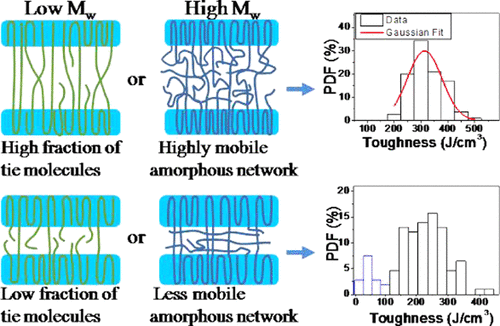当前位置:
X-MOL 学术
›
Macromolecules
›
论文详情
Our official English website, www.x-mol.net, welcomes your feedback! (Note: you will need to create a separate account there.)
Gaussian and Non-Gaussian Distributions of Fracture Properties in Tensile Stretching of High-Density Polyethylene
Macromolecules ( IF 5.5 ) Pub Date : 2021-09-16 , DOI: 10.1021/acs.macromol.1c00944 Tao Liao 1 , Xiao Yang 1, 2 , Xintong Zhao 1, 2 , Yujing Tang 3 , Zhiyong Jiang 1 , Yongfeng Men 1, 2
Macromolecules ( IF 5.5 ) Pub Date : 2021-09-16 , DOI: 10.1021/acs.macromol.1c00944 Tao Liao 1 , Xiao Yang 1, 2 , Xintong Zhao 1, 2 , Yujing Tang 3 , Zhiyong Jiang 1 , Yongfeng Men 1, 2
Affiliation

|
The statistical fracture behavior and microstructure of two high-density polyethylene samples with different molecular weights (HDPE-151K and HDPE-932K) were investigated as a function of thermal history conditions utilizing engineering stress–strain measurements, the small-angle X-ray scattering technique, and 1H NMR T2 relaxometry. The probability density functions of elongation at break and fracture toughness were used to characterize the scattered fracture properties. It was found that the distributions of elongation at break and fracture toughness for the quenched sample of HDPE-151K are well fitted with a Gaussian function, whereas both annealed and isothermally crystallized counterparts demonstrate a non-Gaussian distribution of such fracture parameters. In the case of HDPE-932K, a stochastic fracture process is observed for the isothermally crystallized sample. Furthermore, the tie molecule concentration, the phase composition, and the T2 relaxation time were quantitatively evaluated for both systems. The results indicated that a structural defect dominates the fracture behavior in HDPE systems treated at high temperatures. For HDPE-151K, the structural defect originates from the low fraction of tie molecules and thus a low number of stress transmitters after thermal treatment. In the case of HDPE-932K, the structural defect is caused by the less mobile amorphous network as less mobility of the network chains means a less effective transfer of stress that is produced when the sample is elongated. Due to the globally interlocked network being built up by crystalline lamellae and amorphous chains, a portion of structural defects can be stabilized during tensile stretching, thus resulting finally in non-Gaussian distribution of fracture features.
中文翻译:

高密度聚乙烯拉伸拉伸断裂特性的高斯和非高斯分布
利用工程应力-应变测量、小角 X 射线散射,研究了两种不同分子量的高密度聚乙烯样品(HDPE-151K 和 HDPE-932K)的统计断裂行为和微观结构与热历史条件的关系。技术和1 H NMR T 2弛豫。断裂伸长率和断裂韧性的概率密度函数用于表征分散断裂特性。发现 HDPE-151K 淬火样品的断裂伸长率和断裂韧性的分布与高斯函数很好地拟合,而退火和等温结晶的对应物均表明此类断裂参数的非高斯分布。在 HDPE-932K 的情况下,观察到等温结晶样品的随机断裂过程。此外,连接分子浓度、相组成和T 2对两个系统的弛豫时间进行了定量评估。结果表明,在高温处理的 HDPE 系统中,结构缺陷主导了断裂行为。对于 HDPE-151K,结构缺陷源于低比例的连接分子,因此热处理后的应力传递器数量较少。在 HDPE-932K 的情况下,结构缺陷是由移动性较低的非晶网络引起的,因为网络链的移动性较低意味着拉长样品时产生的应力传递效率较低。由于晶体片层和非晶链构成的全局互锁网络,在拉伸拉伸过程中可以稳定部分结构缺陷,从而最终导致断裂特征的非高斯分布。
更新日期:2021-09-28
中文翻译:

高密度聚乙烯拉伸拉伸断裂特性的高斯和非高斯分布
利用工程应力-应变测量、小角 X 射线散射,研究了两种不同分子量的高密度聚乙烯样品(HDPE-151K 和 HDPE-932K)的统计断裂行为和微观结构与热历史条件的关系。技术和1 H NMR T 2弛豫。断裂伸长率和断裂韧性的概率密度函数用于表征分散断裂特性。发现 HDPE-151K 淬火样品的断裂伸长率和断裂韧性的分布与高斯函数很好地拟合,而退火和等温结晶的对应物均表明此类断裂参数的非高斯分布。在 HDPE-932K 的情况下,观察到等温结晶样品的随机断裂过程。此外,连接分子浓度、相组成和T 2对两个系统的弛豫时间进行了定量评估。结果表明,在高温处理的 HDPE 系统中,结构缺陷主导了断裂行为。对于 HDPE-151K,结构缺陷源于低比例的连接分子,因此热处理后的应力传递器数量较少。在 HDPE-932K 的情况下,结构缺陷是由移动性较低的非晶网络引起的,因为网络链的移动性较低意味着拉长样品时产生的应力传递效率较低。由于晶体片层和非晶链构成的全局互锁网络,在拉伸拉伸过程中可以稳定部分结构缺陷,从而最终导致断裂特征的非高斯分布。



























 京公网安备 11010802027423号
京公网安备 11010802027423号